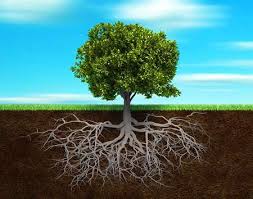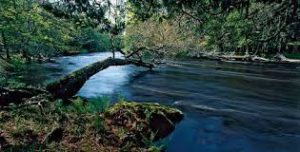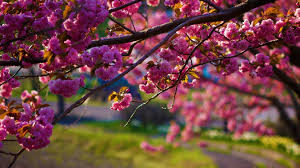Of course trees are conscious. What we have here is latent energy, vitality and capacity, with much of it withheld or suspended momentarily. The tree is dissociated in one manner. In some ways, its living forces and consciousness are kept to a minimum. It is in a state of drowsiness on the one hand; and on the other, it focuses the usable portion of its energy into being a tree.
The state of consciousness involved here is dull as compared to the highly differentiated human ability in many ways. However, in other ways, the experiences of the tree are extremely deep, dealing with the inner senses which are also properties of treedom.
The inner senses of the tree have strong affinity with the properties of the earth itself. They feel their growing. They listen to their growing as we might listen to our own heartbeat. They experience this oneness with their own growth, and they also feel pain. The pain, while definite, unpleasant and sometimes agonizing, is not of an emotional nature in the same way that we experience pain. In some ways, it is even a deeper thing. The analogy may not be perfect, far from it, but it is as if our breath were to be suddenly cut off — in a manner, this somewhat approximates pain for a tree.
The tree makes adjustments just as we do. It listens to its growth up from the earth and to the murmur of the growth of its roots beneath. It adjusts each root ending according to what impediments might lie in its way. Without the conscious mind of man it nevertheless retains this inner consciousness of all its parts, above and below the ground, and manipulates them constantly.
The tree is also aware of its environment to an astonishing degree. It maintains constant awareness and the ability to adjust itself in two completely different worlds, so to speak — one in which it meets little resistance in growing upward and one composed of much heavier elements into which it must grow downward. Man needs artificial methods to operate effectively on land or in water, but the so-called unconscious tree manages nicely in two worlds as diverse, certainly, as land and water, and makes itself a part of each.
And as far as motion is concerned, the tree moves upward and downward. It is quite unfair to say that it cannot transport itself, since it does so to an amazing degree; the roots and limbs moving in all directions. The inner senses of all plant life are well attuned, alert and very vital. All of these fragments have consciousness to a rather high degree, considering the man holds them in such low repute.
My readers of my previous blogs, remember of the trance state — in a light trance, we are able to maintain awareness of self, our environment and our place in it. We simply behave somewhat differently, not bestirring ourselves in any direction unless the suggestion to do so has been given. The awareness of plant life lies along these lines.
Now, in a deep trance the subject, though fully aware of what is happening in the trance, may remember nothing of it afterward. The awareness of plant life is also somewhat like that of the subject in deep trance. Except for the suggestion and stimulus received by regular natural forces on our plane, the plant life does not bestir itself in other directions. But like the trance subject, our plant is aware. Its other abilities lie unused for the time, and latent, but they are present.
The awareness is focused along certain lines. The tree lives through its inner senses, experiencing many sensations and reacting to many stimuli of which we are unaware. Minute earth tremors, even the motion of small ants about its lower trunk. — these are recognized and experienced. Such invisibilities as humidity, radioactivity and all electrical values are felt as quite real things to our tree.
A tree knows a human being also, by the weight of a boy upon its branches, by the vibrations in the air as adults pass, which hit the tree’s trunk at varying distances, and even by voices. My readers must remember what I said in previous blogs about mental enzymes and my remark that color can sometimes be heard. The tree recognizes a human being, though it does not see the human being in out terms. It does not build up the image of a man or woman, but it builds up a composite sensation which represents, say, a given individual. And the tree will recognize the same man or woman who passes it by each day.
As our own body senses temperature changes, it also senses the psychic charge, not only of other individuals, but of plant and vegetative matter. Our tree builds up a composite of sensations of this sort, sensing not the physical dimensions of a material object, whatever it is, but the vital psychic formation within and about it.
Size is sensed by a tree, however, perhaps because of its inherent concern with height. The table around which my wife walks senses, even as she senses it.
Man’s and woman’s ego causes him or her to interpret everything else in light of himself or herself. He or she loses much in this manner. The ego can be compared to the bark of a tree. The bark is flexible, vibrant, and grows with the growth beneath. It is a tree’s contact with the outer world, the tree’s interpreter and, to some degree, the tree’s companion. So should man’s and woman’s ego be.
When man’s and woman’s ego turns instead into a shell — when instead of interpreting outside conditions, it reacts too violently against them, then it hardens and becomes an imprisoning form that begins to snuff out important data and to keep enlarging information from the inner self. The ego’s purpose is protective. The ego is also a device to enable the inner self to inhabit the physical plane.
If, for example, our tree bark grew fearful of stormy weather and began to harden itself against the elements, in a well-meaning but distorted protective spirit, then the tree would die. This is what the ego does when it reacts too violently to purely physical data. As a result, it stiffens, and then we have, a well-meaning self, the cold detachment with which we at one time faced the world.
Nevertheless, let remind you that the tree’s bark is quite necessary and cannot be dispensed with.
The idea of dissociation could be likened to the slight distance between the bark and the inside of the tree. Here we do not have a rigid bark, as we could not have a rigid ego. We have instead a flexible bark, changing with the elements, protecting the inner tree (or inner self), but flexible, opening or closing in rhythmic motion.
The inner tree can continue to grow because the bark is resilient. It bends with the wind. It does not bend when there is no wind, nor does it stiffen, stopping the flow of sap to the treetop for fear that the dumb tree, not knowing what it was up to, would bump its head against the sky.
Neither should the ego react so violently that it remembers and reacts to past storms in the midst of clear and sunny weather. Such a tree bark would be death to the tree. What we must still understand is that the same applies to any individual and the ego. It applies to us all. And we must learn that it is equally ridiculous to act as it is a summer day in the middle of wintertime. The tree has enough sense not to show blossoms in a blizzard.
“The Trees in the Forest”
The tree in the forest
Stand secret and silent,
their voices suspended
In lungs of leaves
That only can whisper
Of dreams held dormant,
That breathe only once
In a thousand years.
Deep is the sleep
Of the moss and the pebble.
Long is the trance
Of the grass and the meadow.
Footfalls come and footfalls pass,
But no sounds can break
That green-eyed trance.










